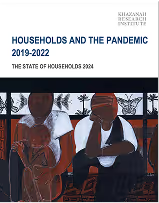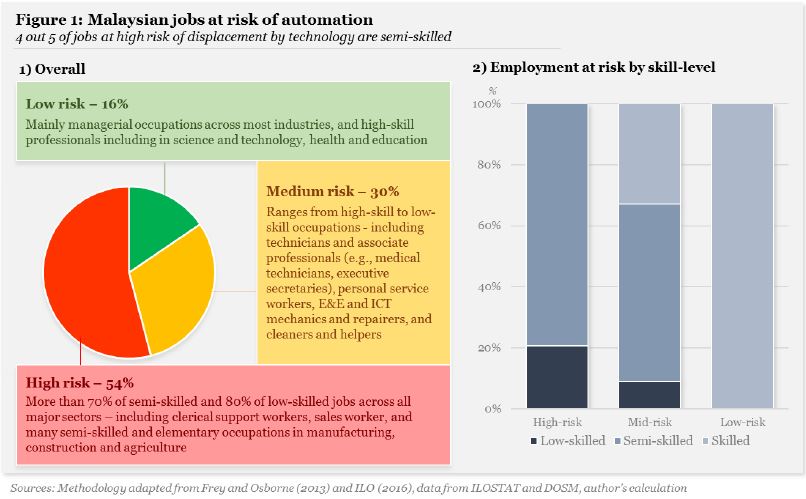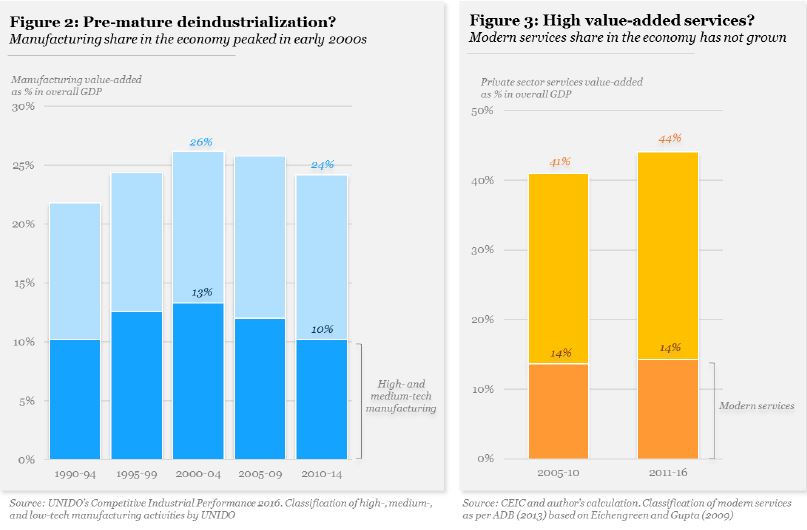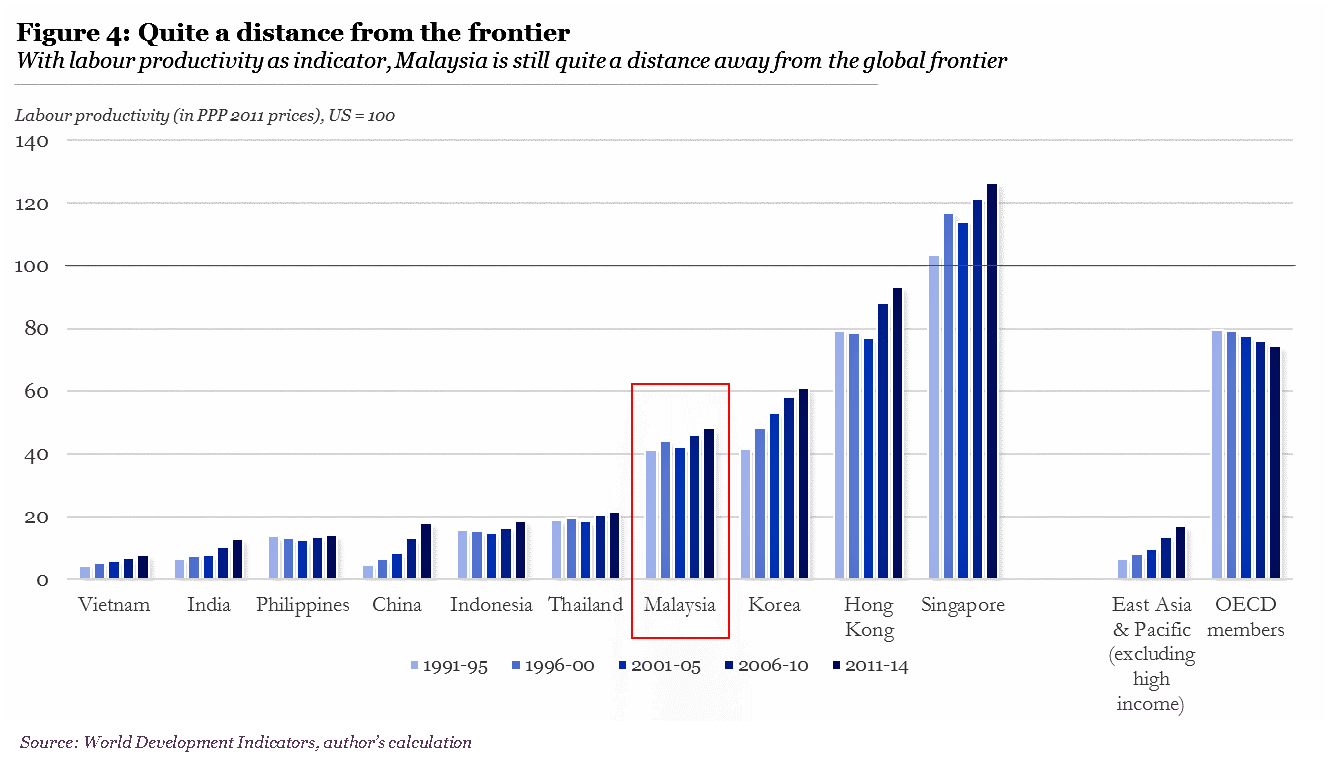
“Economic progress, in capitalist society, means turmoil.”
Joseph Schumpeter (1942, p 31)
Introduction – the line it is drawn
In one of its final acts, President Obama’s administration published two comprehensive reports[1] on preparing the United States for the economic and social transformation that would be brought about by the advances in artificial intelligence (AI) and automation. Earlier in the year, the Korean government laid out an AI industrial development strategy[2], spurred by the increased public attention on the impact of AI after Google’s AlphaGo AI program defeated the world’s top ranked Go grandmaster – a feat previously thought impossible given the complexity of the game. Closer to home, Singapore’s Committee on the Future Economy, a 30-member high-level group led by the finance minister, outlined in February this year the strategic directions for Singapore’s long-term economic development in an era of rapid technological change[3].
Discussions on AI, robotics, advanced data analytics, and many other breakthrough technologies are no longer at the periphery. Governments[4] throughout the world are recognising and responding with great urgency to these unprecedented technological advances. Together, their impact on pre-existing economic and social structures has the potential to drastically alter economies. They can reshape global value chains, supplant entire industries, and displace many existing workers, even as they bring forth new opportunities for the future.
Malaysia, as with all economies closely integrated with the global economy, will not be spared from these changes. Drawing on existing work in the literature, this essay explores this issue in the context of Malaysia – beginning with an assessment of future of jobs at risk of technological displacement before proceeding to a discussion on the broader implications to Malaysia's economic development in the decades to come.
The future is not what it was before – new general purpose technologies
Before turning to Malaysia, it is useful to understand why the current technological advances are fundamentally significant. That technological change is an important determinant of modern economic growth is an idea that is well-agreed upon by economists. But not all technological changes are equal. In the literature on economic growth, distinction is given to a class of technologies known as general purpose technologies (GPTs) that have implications on productivity and the broader economy that are orders of magnitude greater than more typical incremental technologies[5].GPTs are seen as enabling technologies that are pervasive and can lead to generalised productivity gains economy-wide over a long period of time by transforming the underlying productivity potentials of an economy. The arrival of GPTs could dominate macro-economic outcomes, and the effects are typically uneven and disruptive as pre-existing social and economic structures are altered. The classical GPTs discussed in the literature are steam, electricity, and information and communication technology (ICT). These GPTs brought about the classical great economic transformations – the first two industrial revolutions and the information age – which fundamentally shifted productivity, transformed economies and reshaped globalisation[6].
The current confluence of technological advances – with AI being the most consequential – is increasingly recognised as the new GPTs that will bring about the next great economic transformation – a new industrial revolution. A comprehensive discussion on why this is so is beyond the scope of this essay[7], but it is instructive to briefly consider three inter-related characteristics of the current technological advances.
First is spread. Applicability of AI, advanced data analytics, cloud computing, and other technologies are not confined to any single industries. Instead, they have the potential to disrupt many different if not all industries. Indeed, many industries are already affected – from manufacturing, healthcare, transport, retail, to finance. As Andrew Ng – the former chief scientist of Baidu Research – said, AI is the new electricity; just as electricity transformed industry after industry in the late 19th century, so will AI in the coming years with no major industries left unaffected[8].
Second is the nature of these technologies. While the first industrial revolution saw technologies substituting and surpassing manual labour and horse-power, we are now witnessing technologies substituting and surpassing our cognitive abilities. As Brynjolfsson and McAfee (2014) highlighted – AI and related technologies are doing for mental power what the steam engine and its descendants did for muscle power, and this is highly consequential as it has the potential to displace many skilled employments.
Third is the pace of progress. Driven by the combined exponential growth[9] in the computing power of machines, the creation of digital information, the network of connected devices, and backed by the investments of some of the biggest companies in the world, the pace of progress for these technologies is very rapid[10]. So rapid is the improvement that even experts tend to underestimate it. Sergey Brin, the co-founder of Google, admitted in Davos early this year that he was surprised by the speed of AI advancement despite being in the front seat of its research and development[11].
These three characteristics point towards a fundamentally changed future that is closer than we think.
Technical unemployment – the future of employment at risk
Carl Frey and Michael Osborne from the University of Oxford wrote a highly influential paper in 2013 on the probability of jobs being displaced by the current technological advancements. They estimated that 47 per cent of jobs in the United States are at high risk of being displaced within the next two decades. Since, their approach has been applied to many other economies to uncover similar high proportion of jobs at risk of automation, typically with developing economies faring worse[12]. More recently, ILO (2016) replicated the study for five ASEAN countries – Cambodia, Indonesia, the Philippines, Thailand, and Vietnam – and found the number to be 56 per cent.
Earlier studies[13] on employment and automation classify occupations along spectrums of two attributes – routine versus non-routine, and manual versus cognitive – with occupations that involve predominantly routine and manual tasks being more susceptible to automation compared to those that have predominantly non-routine tasks requiring more subjective cognitive-skill. Recent technological advances, however, have significantly expanded the possibilities of tasks that could be replaced by machines. As per Frey and Osborne (2013), it is already technically feasible to automate almost any task, provided sufficient data and computing power. The occupations that are most resistant to automation are those that have three characteristics – creative intelligence, social intelligence, and high degree of perception and manipulation.
Along these three characteristics, Frey and Osborne (2013) evaluated the probability of automation for a detailed list of occupations in the United States, and categorised them into low-risk (below 30 per cent probability), medium-risk (30 per cent to 70 per cent) and high-risk (above 70 per cent). Per this, examples of occupations that are at low-risk are counsellors and therapists, teachers, academics, and most high-skilled professionals such as engineers, and architects, while telemarketer, clerks, paralegals and elementary factory workers are examples of high-risk occupations. ILO (2016) mapped the same automation probabilities to standard international occupational classifications, and applied them to micro-level labour statistics for the five ASEAN countries.
This essay adopts the same approach by ILO (2016), but is subjected to the limitation of publicly available data - micro-level labour statistics are not published in Malaysia. As such the results should be interpreted as an approximation rather than a precise replication of the exact methods of Frey and Osborne (2013) and ILO (2016), applied to the case of Malaysia[14].
Based on this, 54 per cent of all jobs in Malaysia could be at high risk of being displaced by technology in the next two decades. The number is alarming, but not unexpected given similar findings for other countries. By skill level, more than 70 per cent of all semi-skilled and 80 per cent of all low-skilled jobs are at high risk. These occupations cut across all major economic sectors. Skilled jobs are also not unaffected – about 40 per cent of skilled jobs are at medium risk. Proportionately, it is the semi-skilled jobs that are most affected – 4 out of 5 of all jobs at high risk of technological displacement are semi-skilled. Appendix 3 provides greater details of the results, including by gender and the types of jobs in each skill-category.

Before moving on, it is useful to highlight some caveats. Firstly, the methodology employed is not meant to predict with precision the number of jobs that will be lost and when. It is intended to provide an approximation – based on the nature of tasks involved – the proportion of current jobs that is subject to high probability of being automated over the next two decades. Rather than precision, the exercise is more to illustrate that the possible scale of technological unemployment is not trivial. In addition, the estimation for Malaysia in this essay is also subjected to the data limitation as explained earlier and thus should not be interpreted as an exact replication, but instead and approximation of Frey and Osborne (2013) and ILO (2016)[15].
Secondly, as discussed in Arntz et. al. (2016), automation targets specific tasks rather than the occupations themselves, which are combinations of a multitude of tasks. This has important consequence. The very natures of occupations are likely to change as some of their associated tasks become automatable in the future, so not all occupations will be entirely automated away. This implies that while many jobs could be affected by automation, the risk of complete job displacement could be significantly lower. Indeed, White House (2016b) used Frey and Osborne’s (2013) estimate as the upper range for jobs at risk of technological displacement for the case of the United States.
Lastly, the fact that an occupation can be automated does not mean that it will be. Labour market conditions and potential economic benefit that could be derived from adopting automation are key in determining the actual extent of automation[16].Reliance and relative abundance of low-wage labour could disincentivise firms from adopting more advanced technologies. In addition, the lack of skilled workers with the required competencies could also prevent firms from using modern labour-saving technologies effectively. The fact that adoption of technologies could be slower and less extensive in Malaysia, however, is not a reason to rejoice, as the next section explains.
Convergence to the frontier – securing sustained economic development
The direct implication of these findings on the Malaysian labour market, if the technological displacement does come to pass, is quite dire. There is the view that with the adoption of automation, our reliance on low-skill foreign labour could be reduced. From the findings in this essay, while adoption of the current form of automation technologies could reduce our reliance on low-skilled workers, it is in fact the semi-skilled occupations that are the most at risk of displacement. It is important to note that about 90 per cent of all semi-skilled jobs in the country are held by Malaysians. If large scale technological displacement does occur, the socio-economic environment of the country could face unprecedented stress, with a large proportion of Malaysians left under-employed or without jobs completely, coupled with growing inequality between highly skilled workers and technology owners, and semi-skilled and unskilled workers.
However, with continued abundant access to low-wage workers and an employment structure that is skewed against high-skilled workers, it is likely that Malaysia will be relatively slow in adopting the latest labour-saving automation technologies. This, however, presents a different and perhaps more significant challenge to our broader economic development.
The relevant question is – what would happen to Malaysia when the United States, Germany, China and other major economies adopt greater automation? There are two possible inter-related consequences. First, the increased use of labour-saving technologies in the major economies could erode the labour-cost advantage of Malaysian manufacturing. The potential reshoring of manufacturing activities back to these major economies could lead to the shrinking of our export-oriented manufacturing activities. Secondly, the adoption of modern production technologies could transform pre-existing global value chains (GVCs), in which case even if reshoring does not completely occur, Malaysia could risk being unplugged from the new GVCs without the necessary technological readiness. Overall this could accelerate Malaysia’s deindustrialisation and further lowering of our economy’s participation in GVCs.
It is important to note that Malaysia had already reached peak industrialisation, in terms of value-added, in 2000. Since then, the economy has steadily deindustrialised without significant expansion in modern services to replace the reduced share of high- and medium-tech manufacturing (Figure 2 and 3). Similarly, our overall participation in GVCs has declined over the same period[17].If Malaysia fails to successfully adapt to the unprecedented global technological advances, we risk further exacerbating this trend.
The implication this has on Malaysia’s economic development in the decades to come is highly consequential. Unlike advanced economies in the past, many emerging economies are experiencing deindustrialisation at much lower levels of income, and before significant development of modern services. As Rodrik (2016) persuasively articulated, this ‘pre-mature deindustrialisation’ poses significant challenge for emerging economies – it reduces economic growth potential and the possibilities for convergence with income levels of the advanced economies. Manufacturing tends to be the most productive and technologically dynamic sector, exhibiting unconditional convergence with global frontier. ‘Pre-mature deindustrialisation’ could result in a growth-reducing structural change that removes the main channel for emerging economies to escape their emerging status. As Figure 4 highlights, the Malaysian economy is still quite a distance away from the global frontier – we cannot afford to have the path to convergence closed to us if Malaysia is to sustain its economic development and to become a developed economy in the coming decades.

It is important to recognise that the technological advances, while potentially very disruptive, can bring significant economic opportunities to economic development if harnessed effectively. For example, even now AI technologies are already expanding benefits in economic development – such as in education through personalised learning, in healthcare through deep diagnostics, and in agriculture through precision farming (World Bank, 2016). Further ahead however, the major economic opportunities that will be created in the coming few decades arising from these breakthrough technologies remain very difficult to predict. At this point, there are many possibilities but none that we can pinpoint with certainty.
Malaysia’s capacity to manoeuvre successfully in turning the risks we face into opportunities that can enhance our economic development rests on our commitment in two policy imperatives[18]. The first is industrial policies that are underpinned by deep sector-based understanding to enhance technological readiness of our industries and promote growth-enhancing structural change of the economy more generally. This would include nurturing an enabling environment to incentivise the application of new technologies, and to develop an ecosystem for innovation, and research and development. The second is education policies that would be able to effectively prepare and equip all Malaysians with the relevant skills for the future, and with an emphasis on lifelong learning. This is critical given the rapid pace of technological progress that is accelerating the pace of knowledge and skill obsolescence. In addition to industrial and education policies, a focus on quality job creation by micro, small and medium-sized enterprises (SMEs) is also essential to ensure continued growth of employment and to mitigate the risk of technological unemployment. SMEs are the largest sources of job creation in Malaysia, and the significance is expected to increase going forward. This can be done, amongst others, by leveraging on the opportunities from new technological platforms that have the potential to significantly improve efficiency in many traditional economic activities – especially in the services sector. 90 per cent of all SMEs in Malaysia are in the services sector.
A key point to acknowledge, however, is that the policy environment is changing considerably. Given significant uncertainty, growing complexity, and rapid change, policy-makers are now in a situation with significantly less informational advantage than previously. To ensure relevance and responsiveness, policies would need to be continuously informed and driven from the ground up – from the private sector – where the informational advantage lies.

Conclusion – as the present now, will later be past
Despite the tone of this essay, this author is an optimist when it comes to technology and its impact on the economy. The long history of economic development is, after all, a story of technological progress and how it made economies more productive, thus making permanent increases in the standard of living possible. As Paul Krugman famously said[19],“productivity isn't everything, but in the long run it is almost everything”. There is very little reason to believe that this time will be significantly different in the long run.
The challenge, however, lies between now and the long run.
In this, Malaysia’s experience in the past offers another reason to be optimistic. In the mid-1980s, while facing a world that was still recovering from recessions in the advanced economies and weak commodity prices, Malaysia took bold policy initiatives to change the economy. We launched a comprehensive industrial policy agenda in 1986 to transform the structure of the economy and to integrate the domestic economy with the world. It was also at around this period that, for the first time ever, more Malaysians had secondary education than primary education – an outcome of our policy commitment to education. By the time the ICT-driven global economic transformation arrived in the early 1990s, the foundations had already been laid and we reaped the benefits. This was when Malaysia was known as an East Asian miracle.
If we could rise to the challenge in the past, we can do so again for the new challenge in the future. But that requires us to begin now.
Author's note: I am grateful for the valuable comments by Tan Sri Andrew Sheng, Dato’ Charon Mokhzani, Lee Heng Guie, Nicholas Khaw, Philip Schellekens and Suraya Ismail. I thank Gregory Ho for his excellent research assistance. All errors remain my own.






.jpg)








